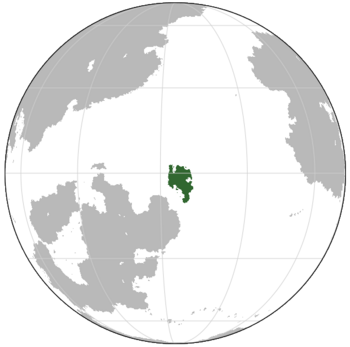Los Angeles
Free Democratic Republic of the Island of Los Angeles 3 official names
| |||||||||
|---|---|---|---|---|---|---|---|---|---|
| Anthem: The People's March | |||||||||
 | |||||||||
| Capital and largest city | Playadiestat | ||||||||
| Official languages | Conversilha Engelpraaten Agnian Serran | ||||||||
| Ethnic groups (2023) |
| ||||||||
| Religion (2015) |
| ||||||||
| Demonym(s) | Angelean | ||||||||
| Government | Unitary Parliamentary Republic | ||||||||
| Ricardo Johansen | |||||||||
| Willem Aalves | |||||||||
| Luzia Faria | |||||||||
| Legislature | Grand National Congress | ||||||||
| Presidium | |||||||||
| Supreme National Council | |||||||||
| Established | |||||||||
| 1607 AD | |||||||||
| 1629 AD | |||||||||
| 1702 AD | |||||||||
| 7 April 1801 | |||||||||
| April 1968 | |||||||||
| 2 March 1986 | |||||||||
| Population | |||||||||
• 2023 estimate | 30,200,000 (11) | ||||||||
• 2015 census | 29,092,321 | ||||||||
| GDP (nominal) | 2022 estimate | ||||||||
• Total | |||||||||
• Per capita | |||||||||
| Gini (2022) | medium | ||||||||
| HDI (2022) | very high | ||||||||
| Currency | Angelean Valero (V͇) (AVA) | ||||||||
| Date format | dd/mm/yyyy | ||||||||
| Driving side | right | ||||||||
| Calling code | +80 | ||||||||
| ISO 3166 code | LA | ||||||||
| Internet TLD | .la | ||||||||
Los Angeles, officially the Free Democratic Republic of Los Angeles, is a sovereign country comprised of the Island of Los Angeles and numerous smaller islands. It is one of the largest island states on Manala, with just over 30 million people. It has a diverse climate, with tropical regions in the southern half and northern tip separated by a highland, where the ocean and higher temperatures play a moderating effect on the country's climate. Further east, this highland turns into dry desert.
The ancestors of Indigenous Angeleans came from an unknown location. Some recent evidence has led historians to theorize that roughly 30-40,0000 years ago indigenous groups arrived by sea from Alanna and began forming their own cultures and groups, but there is no evidence of a signifigant seafaring civilization in Alanna at this time. By the time of the arrival of Serran explorers in the late 1500s the indigenous tribes had maintained some of the longest known cultural traditions in the world. Alannan explorer Mbku Kalenene was the first known nonnative to arrive in what is now Los Angeles in 1401, but he arrived in the desert portion of the country and decided never to return. Onslander explorer Jeroen Vlootman discovered some of the more habitable portions of the island in 1429 and reported them back to the Onslander Empire, which settled some small trade outposts in the south over the 1440s, most notably what is now the town of Jerostad. These Onslander settlements struggled in the tropical climate and with raids from Alannan pirates posing a major issue. A Ndibeanyan chain of settlements was established in the 1460s, but were abandoned by 1480 due to a greater need for troops and resources back home in one of the internecine wars in what is now in Alanna.
It would not be until 1500 that that the Serran explorer Álvar Hernando de Paoloa discovered the island for the Serrans. In 1504, Paoloa returned with a colony and established the town of Nueva Serran.

